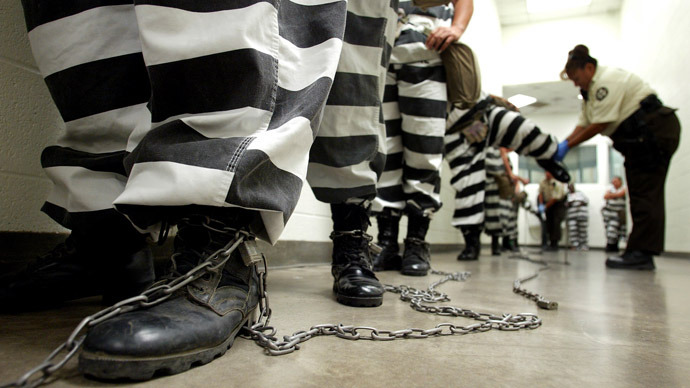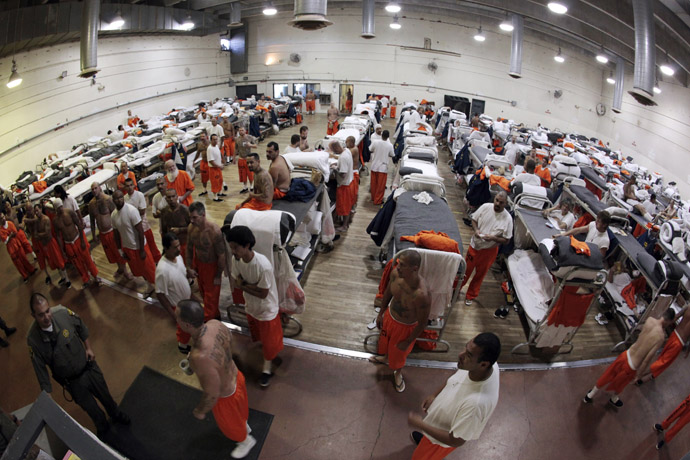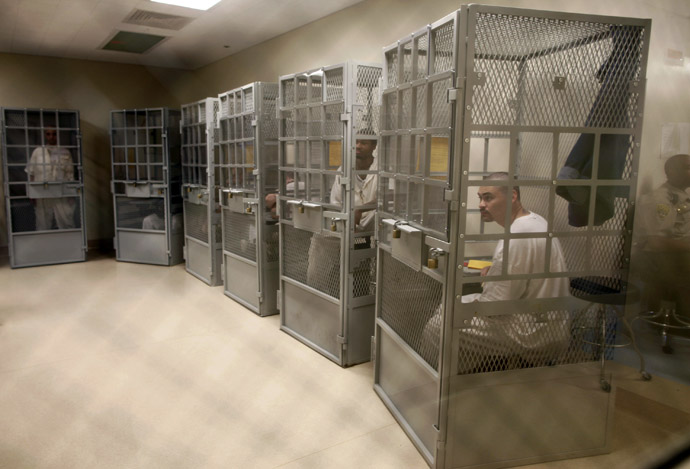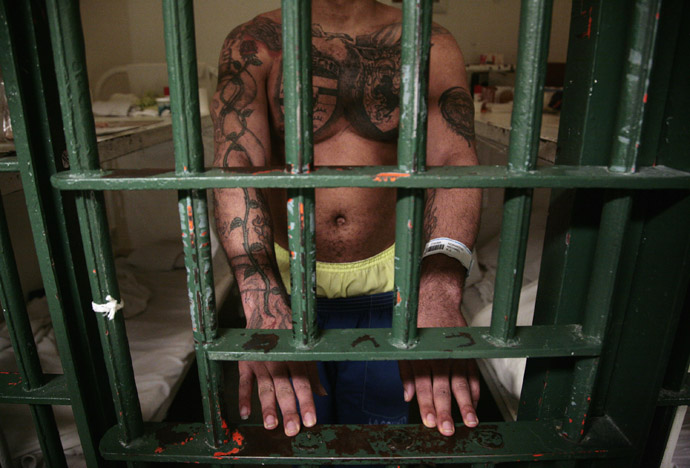Moral monstrosity: America’s for-profit Gulag system

The private prison population in the US has rocketed 17-fold over the last two decades mostly on the shoulders of the deep-pocketed prison lobby, and the business continues to thrive.
Try confining yourself to a small room in your home, like a bathroom or a closet, and spend a few hours there. One only cringes to imagine the detrimental psychological effects that kind of solitude creates for individuals who are subjected to solitary confinement for years at a time, knowing only the walls of their cell and the shades of light that creep across them. The abhorrent state of affairs at the Guantanamo facility often makes international headlines and arguably overshadows the calamity that is the US domestic prison system – where over six million people are subject to some form of correctional supervision, an amount exceeding those who toiled in the Soviet gulags during Stalin’s reign. In the United States, some fifty thousand inmates pass their days in solitary confinement. While there is undoubtedly no shortage of violent criminals in America’s jails, millions are dolled out annually by privately owned prison lobbies directly to politicians in an effort to influence harsher ‘zero tolerance’ legislation and mandatory sentencing for many non-violent offenses.
While the US faces economic stagnation and unprecedented spending cuts to programs of social uplift, business is booming for the private prison industry. Like any other business, these institutions are run for the purpose of turning a profit. State and federal prisons are contracted out to private companies who are paid a fixed amount to house each inmate per day. Their profit depends on spending the minimum amount necessary on each inmate day-to-day, allowing private-hands to pocket the remaining money. For the corrections conglomerates of America, success depends on housing the maximum numbers of inmates for the longest potential time as inexpensively as possible. Consider that the United States has the highest incarceration rate in the world, far surpassing any other nation – for every 100,000 Americans, 743 citizens sit behind bars. The harsher sentences meted out to non-violent offenders in contrast to other industrialized nations speaks volumes of America’s enthusiastic embrace of a prison industrial complex.

The number of people imprisoned under state and federal custody increased 772% percent between 1970 and 2009, largely due to the incredible influence that private corrections corporations wield against the American legal system. The argument is that by subjecting correctional services to market pressures, efficiencies will be increased and prison facilities can be run at a lower cost due to market competition. What these privatizations produce in turn is a system that destroys families by incentivizing the mass long-term detention of non-violent criminals, a system that is increasingly difficult to deconstruct and reform due to millions paid out to state and federal policymakers. According to reports issued by advocacy group Public Campaign, the three major corrections firms –Corrections Corporation of America (CCA), the GEO Group, and Cornell, have spent over $22 million lobbying Congress since 2001.
As a means of influencing policymaking at the federal level, at least $3.3 million have been given to political parties, candidates, and their political action committees, while more than $7.3 million has been given to state candidates and political parties since 2001, including $1.9 million in 2010, the highest amount in the past decade. Senators like Lindsay Graham and John McCain have received significant sums from the private prison corporations while Chuck Schumer, Chair of the Rules Committee on Immigration and Border Enforcement, received at least $64,000 from lobbyists. The prison lobby thrives off of laws that criminalize migrants and submit them to mandatory detention prior to being deported, sometimes up to 10 months or more; private firms have consistently pushed for the classification of immigration violations as felonies to justify throwing more and more immigrants behind bars. The number of illegal immigrants being incarcerated inside the United States has risen exponentially under Immigration and Customs Enforcement, an agency responsible for annually overseeing the imprisonment of 400,000 foreign nationals at the cost of over $1.9 billion on custody-related operations.
The private prison industry has become increasingly dependent on immigration-detention contracts, and the huge contributions of the prison lobby towards drafting Arizona’s controversial immigration law SB 1070 are all but unexpected. Arizona's SB 1070 requires police to determine the immigration status of someone arrested or detained when there is “reasonable suspicion” that they’ve illegally entered the US, which many view as an invitation for rampant racial profiling against non-whites. While the administration of Arizona’s Governor Jan Brewer is lined with former private prison lobbyists, its Department of Corrections budget has been raised by $10 million in 2012, while all other Arizona state agencies were subject to budget cuts during that fiscal year. The concept of privatizing prisons to reduce expenses comes at great cost to the inmates detained, who are subjected to living in increasingly squalid conditions in jail cells across America. In 2007, the Texas Youth Commission (TYC), a state agency that overseas juvenile corrections facilities, was sent to a West Texas juvenile prison run by GEO Group for the purpose of monitoring its quality standards.

The monitors sent by the TYC were subsequently fired for failing to report the sordid conditions they witnessed in the facility while they awarded the GEO Group with an overall compliance score of nearly 100% - it was later discovered that the TYC monitors were employed by the GEO Group. Independent auditors later visited the facility and discovered that inmates were forced to urinate or defecate in small containers due to a lack of toilets in some of the cells. The independent commission also noted in their list of reported findings that the facility racially segregated prisoners and denied inmates access to lawyers and medical treatment. The ACLU and Southern Poverty Law Center have also highlighted several cases where GEO Group facility administrators turned a blind eye to brutal cases of rape and torture within their facilities, in addition to cases of its staff engaging in violence against inmates. According to the Justice Department data, nearly 210,000 prisoners are abused annually (prison personnel are found responsible half the time), while 4.5 percent of all inmates reported sexual assaults and rape.
It’s not possible to conceive how such institutionalized repression can be rolled back when the Obama administration shows only complicity with the status quo – a staggering $18 billion was spent by his administration on immigration enforcement, including detention, more than all other federal law enforcement agencies combined. Under Obama’s watch, today’s private prison population is over 17 times larger than the figure two decades earlier. Accordingly, Obama’s drug czar, Gil Kerlikowske, has condemned the recently passed state laws in Colorado and Washington that legalize the possession of marijuana in small amounts. The Obama administration is bent on keeping in place the current federal legislation, where a first-time offender caught with marijuana can be thrown in prison for a year. It’s easy to see why common-sense decriminalization is stifled - an annual report released by the CCA in 2010 reiterates the importance of keeping in place harsh sentencing standards, “The demand for our facilities and services could be adversely affected by the relaxation of enforcement efforts, leniency in conviction or parole standards and sentencing practices or through the decriminalization of certain activities that are currently proscribed by our criminal laws. For instance, any changes with respect to drugs and controlled substances or illegal immigration could affect the number of persons arrested, convicted, and sentenced, thereby potentially reducing demand for correctional facilities to house them.”

Such is the nature of a perverted brand of capitalism, and today’s model bares little difference to the first private prisons introduced following the abolishment of slavery in the late 1800s, where expansive prison farms replaced slave plantations where predominately African-American inmates were made to pick cotton and construct railroads in states such as Alabama, Georgia and Mississippi. Today, African-Americans make up 40% of the prison population and are incarcerated seven times more often than whites, despite the fact that African-Americans make up only 12% of the population. Inmates are barred from voting in elections after their release and are denied educational and job opportunities. The disproportionate levels of black people in prisons is undeniably linked to law enforcement’s targeting of intercity black communities through anti-drug stipulations that command maximum sentencing for possession of minute amounts of rock cocaine, a substance that floods poor black neighborhoods.
Perhaps these social ills are byproducts of a system that places predatory profits before human dignity. Compounding the illogic is that state spending on prisons has risen at six times the rate of spending on higher education over the past two decades. Mumia Abu-Jamal, America’s most famous political prisoner, has spent over three decades on death row; he was convicted in 1981 for the murder of a white police officer, while forensic experts say critical evidence vindicating Jamal was withheld from the trial. In an interview with RT, Jamal relates his youth activism with the Black Panthers party against political imprisonment in contrast to the present day situation, “We could not perceive back then of what it would become… you can literally talk about millions of people incarcerated by the prisoner-industrial complex today: men, women and children. And that level of mass incarceration, really mass repression, has to have an immense impact in effect on the other communities, not just among families, but in a social and communal consciousness way, and in inculcation of fear among generations.” The fear and immortality the system perpetuates shows no sign of abating. Being one of the few growth industries the United States has left, one can only imagine how many people will be living in cages in the decades to come.
The statements, views and opinions expressed in this column are solely those of the author and do not necessarily represent those of RT.
The statements, views and opinions expressed in this column are solely those of the author and do not necessarily represent those of RT.













